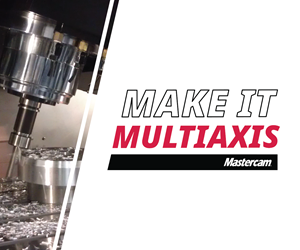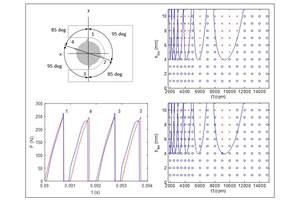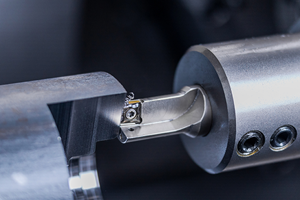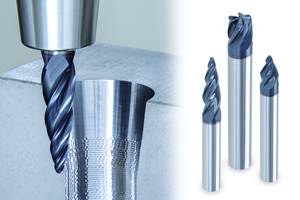Applications Advance for Solid Ceramic End Mills
All they need is speed! Tools for roughing nickel-based alloys can be used in the same processes as carbide tools, just with high rpm and no coolant.
The use of solid ceramic end mills is on the rise, says Thilo Mueller, manager of solid end milling tools with Kennametal. And in a way, that news is less dramatic than it might sound, because solid ceramic end mills are arguably easier to use than carbide ones. Shops applying them need not make special process changes. Contrary to what is often assumed about ceramic tooling, these end mills do not require runout any better than what is used for comparable carbide tools. And because the tools perform effectively when machining dry, considerations related to coolant become irrelevant.
All the tools really need is speed, he says. They employ heat as part of their cutting mechanism—the heat that comes from fast, dry cutting, the same heat that might be destructive to other tools. The best performance with a ceramic end mill generally occurs in a dry machining application in the range of 3,000 to 4,000 sfm.
The increased use of very hard materials accounts for part of the reason why the use of ceramic end mills is increasing, Mr. Mueller says. Nickel-based high-temperature alloys such as Inconel were formerly used only for a narrow range of aerospace-related parts. Now the range of those components in aerospace is increasing, as is the use of these alloys in other industries. And where in the past it was always low-speed, high-torque machine tools that machined these hard materials, the increased availability of machines with high spindle speed for processing this work is another factor enabling ceramic’s advance.
Plus, one more factor is improved tool manufacturing. He says, “Producing ceramic rods or other simple forms is one thing, but sintering ceramic cutting tool material and converting it into the form of a precision end mill is not easy.” Modern sintering methods make this more cost-effective. “It’s also hard to grind these tools,” he notes; “there were lessons to learn here.” Grinding ceramics is one area in which Kennametal has developed skill and techniques that are also helpful in making these tools affordable in the right applications.
But the right application remains key, he says. Relative to carbide, solid ceramic tools are still expensive. Not only is the purchase price higher, but ceramic also offers little to no opportunity for extending useful life through regrinds. The tools therefore require applications in which a dramatic productivity gain over carbide easily justifies the cost difference. Even iron and titanium alloys don’t necessary allow for this, but in nickel-based metals, ceramic tools routinely do deliver this dramatic improvement.
Here is video of what that productivity looks like. The material here is Inconel 725. The “sparks” seen in part of this footage are a result of the tool using heat as part of its cutting action. What look like sparks are actually the material being converted to powder:
Many are aware of ceramic cutting tools only as inserts, Mr. Mueller says. The solid-body ceramic end mill is a complement to this type of tool—useful for the same applications, but at diameters too small for an inserted cutter.
Meanwhile, the tool is also a complement to carbide, he says. Carbide tools are still needed. While ceramic wears much more slowly than carbide in hard materials, it does wear. Indeed, the ceramic tool wears gradually, doing so all the while it is cutting, so that the cutting edge is slowly and constantly changing. The end of the ceramic tool’s life comes only when the edge has entirely eroded away.
As a result, ceramic tools are roughing tools. Ultimately, carbide cutting edges still must perform the final finishing cuts. They do so after the ceramic end mill has delivered high productivity by quickly removing away most of the material.
Related Content
The Impact of Cutting Teeth Spacing on Machining Stability
Many cutter designs are available, and variable teeth spacing (or variable pitch) cutters can be used to influence milling stability. Let’s discuss why teeth spacing affects stability.
Read MoreCeratizit's Updated Tooling Solutions Improve Machining Performance
The company has upgraded its EcoCut indexable inserts lineup, as well as introduced two new toolholding and workholding solutions.
Read MoreAll-Around Mill Improves Productivity and Cost for Valve Job
Adopting a mill with a double-negative rake and pockets compatible with multiple insert geometries enabled Progressive Metal Service to increase feed and lower scrap rates for a valve.
Read MoreTungaloy Expands Line of Barrel-Shaped End Mills
The new SolidMeister barrel end mills are efficient tools for complex 3D-surfacing operations used in mold making, orthopedic implants and the machining of other freeform surfaces.
Read MoreRead Next
Obscure CNC Features That Can Help (or Hurt) You
You cannot begin to take advantage of an available feature if you do not know it exists. Conversely, you will not know how to avoid CNC features that may be detrimental to your process.
Read MoreThe Cut Scene: The Finer Details of Large-Format Machining
Small details and features can have an outsized impact on large parts, such as Barbco’s collapsible utility drill head.
Read More3 Mistakes That Cause CNC Programs to Fail
Despite enhancements to manufacturing technology, there are still issues today that can cause programs to fail. These failures can cause lost time, scrapped parts, damaged machines and even injured operators.
Read More
.jpg;width=70;height=70;mode=crop)















.png;maxWidth=300;quality=90)







